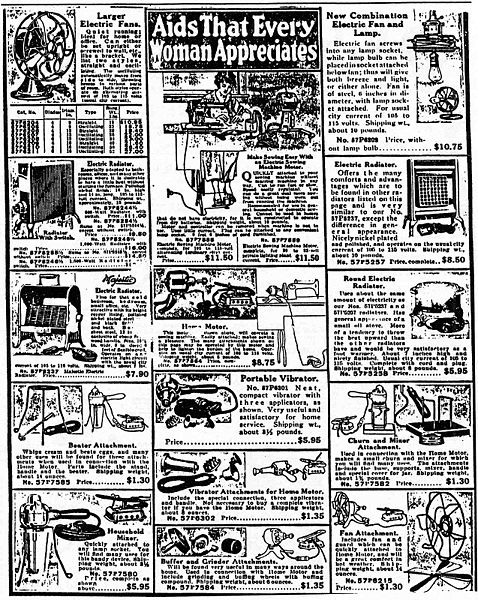In its simplest form, Marketing is the act of satisfying the wants and needs of a population. Everything from market research to advertising are meant to do one thing; to put a product or service offering in the hands of as many consumers as possible.
Early examples of innovative marketing campaigns are the Sears and Roebuck catalog, inserting baseball cards in packages of tobacco, and Henry Ford giving out a package of charcoal briquettes with new cars to promote extended trips. These were all one off ideas that lead to increased sales, but were ultimately isolated instances in a work environment focused on productivity.
Over time businesses became more customer oriented to optimize profitability. Here is a short look back at how modern marketing (traditional marketing to you) evolved out of industrialization, and how companies moved toward the infrastructure we see today.

The Sears and Roebuck catalog was more popular than any other printed document, excluding the bible, in the early 20th century.
Production Orientation
Before World War II the only forces at work in the free market were supply and demand. This led to companies developing a production orientation where they focused primarily on increasing production until they reach the minimum efficient scale.
By taking advantages of the economies of scale, companies could lower their prices while still increasing their profits. Taking a page from Henry Ford and Eli Whitney, production efficiency became the driving force behind the most successful organizations.

The introduction of the assembly line altered the economies of manufacturing. Over the next several decades manufacturers concentrated on optimizing production methods to increase profits even further.
Product Orientation
Sustained peace and wealth coupled with further industrialization and growing conglomerates in the middle of the 20th century led to consumers identifying certain brands as high quality.
Sears and Roebuck, Cadillac, Kirby Vacuum Cleaners, and hundreds of other brands became the first modern name brands. For the first time in history companies moved toward a product orientation, where the reputation and value of their product drove sales and captured market share.
Sales Orientation
The next innovation came when companies started to focus on exploiting the features and quality through direct sales. Direct door to door selling had been practiced for years, but with revitalized products and a need for further growth, businesses started to become more sales oriented. Instead of investing in research and development, corporations such as Avon, the Fuller Brush Company and Kirby Vacuums division of Berkshire Hathaway concentrated on training salespeople to enthusiastically highlight product features and demonstrate product quality.
The focus on sales led to a major shift in the way corporations were organized, and sales methods became the driving force behind the most profitable businesses.

Door to door demonstrations were common in the 1950s and 1960s. The increased focus on sales created a new breed of trained sales associates, the precursor to modern marketing.
Modern Marketing Orientation
Beginning in the 1960s companies started to organize the whole process of sales and production into a business function we know as marketing. Starting with market research, companies aimed to match products closely with the latest consumer tastes.
Through research and development they used science to optimize their product for the market, check their hypothesis against test groups, and test the product for potential problems. Finally, companies would use different types of media and other promotional techniques to make sure potential customers knew the product existed.
For the first time in history the catalyst for corporate profit became the needs and wants of the consumer. The focus of modern marketing became separating consumers from their money. After this major shift in orientation businesses saw continuous growth for nearly four decades and exploding debt rates among consumers. Modern marketing clearly worked, maybe a little too well.
Holistic Social Marketing
Much like the events that triggered the product orientation adopted by companies after World War II, a perfect storm of advancements and setbacks colluded in the last decade to upset the balance of traditional marketing. Dramatic advances in communication and technology came at a time when the world economy finally caught up with itself.
Concepts such as brand loyalty, permission marketing, reputation management and public relations were coming of age while the shortened news cycle made cynics out of viewers that watched O.J. Simpson get acquitted, police storm Columbine High School and Firefighters stumble aimlessly through New York streets after the first tower fell.
The concept of holistic marketing is elaborate, but it doesn’t have to be complicated. New marketing schemes integrate sales, customer service, public relations, advertising, research and development and other traditional marketing roles with a brand philosophy that is presented across points of contact.
Each business function is represented across all marketing channels, which include both traditional media and the newer digital channels that are commonly associated with new marketing. Instead of interrupting your regularly scheduled broadcast, new marketing adds value to it.

Innovations like the DVR give consumers an increased ability to tune out traditional advertising. We now see this type of approach as an interruption, leading brands to start using product placement and other tactics that integrate the message with media.
These new attitudes are a response to new customer expectations, eroding attention spans, and recent inventions such as DVR that allow consumers to tune out advertising more effectively. Permission marketing and content marketing delivered through e-mail and social media channels have become ubiquitous with holistic marketing.
Those same channels are utilized for customer service, product research, sales, and all other marketing functions as well. A united marketing front that is represented wherever people are and is true to the altruistic branding messages that you wish to embody – that’s an example of holistic marketing.
Not as Obvious
It doesn’t take much investigation for anyone to interpret the new attitude that business has taken to marketing in the past decade. Other people have described new marketing before, and a simpler explanation would often suffice.
New Marketing is The Last Stand
What you may not realize is that holistic marketing is the final frontier. There will never be another overriding business orientation because all future developments will be captured in the holistic marketing umbrella. Don’t misinterpret that: things will still evolve, but there are certain facets of a holistic approach that will trump even the most stirring advancements in marketing science.
For example, the next large step will likely be based on a type of psychological marketing. Why do consumers purchase an iPhone or iMac that costs more and is inferior in almost every way to competing products? When consumers are presented with a large library of music that they’re unfamiliar with, they’ll gravitate toward the songs that others have downloaded the most.
In some cases a negative report or small policy adjustment, like Netflix’s justifiable and negligible price increases, spell doom for a brand. In other cases a brand can sustain itself during a prolonged period of negative press. All of these variables and scenarios are on the verge of being predictable through data analysis and behavior forecasting. Marketing is becoming more of a science every day, and complex predictive processes promise to handle the bulk of predictive analytics in the not so distant future.
Regardless of the advancements and evolution marketing takes form here, consumers will maintain their distrust of business, and autonomous computer processes. Any lesser attempt at engaging me is disrespectful.
Companies are starting to fill the role of content creators; the true experts on each product are creating media that maximizes its involvement and quality. The companies that once paid for production as advertisers have bypassed the studios and taken entertainment production into their own hands. The increased access associated with the Internet means that consumers are directing the approach of marketing campaigns, an evolution that won’t soon be relinquished.
Consumers are getting used to customer service representatives being only a tweet away, and avid users of a specific product have gotten used to interacting with that product’s community on Facebook. These are all perks of a customer orientation based on goodwill that will not be taken back lightly.
Remember that a focus on the customer doesn’t always mean they want to teach you; it could mean they want to trick you. Psychology, interpretive and predictive processing will soon optimize marketing to a point that would astonish practitioners today. I’d like to see you get permission to read someone’s mind though.
New Marketing is a Compromise
With this customer centric model, marketing teams allocate resources to the production, product, sales team and marketing division. You can have the best product around, but without distribution you can’t sell anything.
Likewise, the most efficient distribution network is useless without a product to distribute. The employees that man the Point of Sale represent the final opportunity for marketing to blow a sale. You want cashiers and teleworkers to be as experienced and knowledgeable as possible, but all resources dedicated to training labor are resources that cannot be used elsewhere.
New Marketing isn’t about creating the perfect customer experience, but instead creating the best customer experience based on the resources that are available.
Even with proficient distribution, an exceptional product and great sales team, a small delay in shipping can cause affected customers to turn on your brand. Since reciprocity from satisfied customers is a big part of the new marketing strategy, you need to weigh long term cost of a deficiency in one area against the long term cost if that deficiency was in another. Your job is to mitigate loss as much as it is to convert customers to evangelists.
It’s the Same Game, Same Players… Different Uniforms
Products are now the solution you’ve been waiting for. The Magic Bullet isn’t a cheap, super small blender; it’s a tool for weight loss, good health and increased libido!
Promotion and advertisements are now information and entertainment. I will send you my guide for the 10 best Recipes including pistachios, but without a bag of Wonderful Pistachios you can’t cook any of them.
Price is no longer associated with cost, but excessive value. You paid $20,000 for the car, 130$ for the spare tire, but catching the flight for your honeymoon is priceless. For everything else there’s Master Card right? Your Harley Davidson costs 13,000$ and my Bic razor costs 63 cents. They’re both worth every penny though, right?
Conclusion
When you first consider the logistics of a holistic approach to marketing it seems insurmountable. With a little organization and dedication however, the benefits of a holistic approach will soon make the extra work worth the effort; much like the added infrastructure associated with traditional marketing setups proved to be worth its salt through increased profits. Digital marketers look for ways to increase brand awareness, but also lower costs by integrating customer service functions into online FAQs and contact methods.
Through a brand philosophy and core strategic objectives, the holistic approach to marketing has components of production orientation, product orientation, sales orientation, and a traditional marketing orientation. By breaking down barriers between business functions and focusing on consumer needs, new marketing has become the pinnacle of product support.
If your brand hasn’t yet embraced a holistic approach, you don’t know how much more effective the whole idea is than the sum of its parts. Holistic marketing empowers employees to take an active role in brand management and gives you the freedom to do whatever it takes to reach and resonate with customers. I don’t know about you, but I don’t want to go back to selling cake mix door to door.
Source(s)
Adcock, Dennis, Al Halborg, Caroline Ross. Marketing: Principles and Practice. Financial Times/Prentice Hall (2001).
- The Evolution of Marketing: From Catalogs to Cat Blogs - November 8, 2022
- How to Make a Tweet This Link - February 5, 2022
- Dramatically Improve Marketing Results with Advanced Analytics - September 20, 2021
- The Next Chapter for Social Media Sun - June 4, 2013
- Optimizing Your FAQ to Maximize ROI - December 5, 2012
- Blogging Isn’t a Rocket, It’s More Like a Roller Coaster - November 19, 2012
- Weapons of Influence and Klout’s Role in Marketing - November 17, 2012
- The Biggest Problem With Inbound Marketing Blogs Today - November 16, 2012
